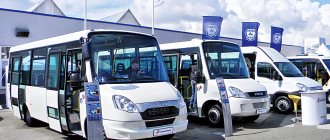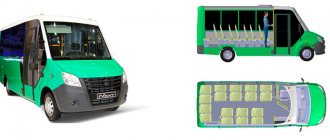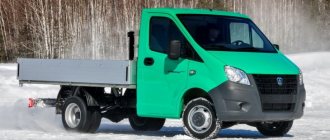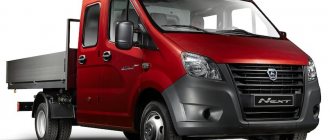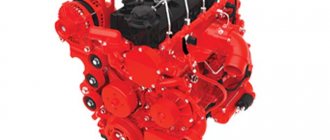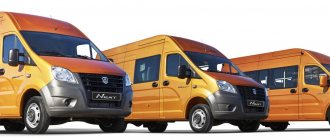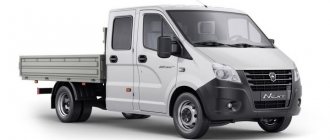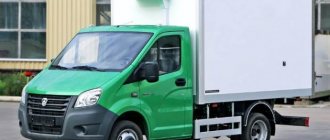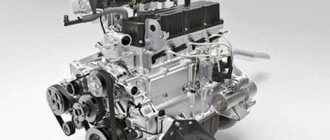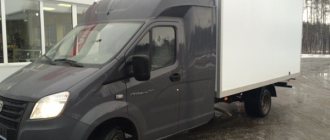Bus GAZelle NEXT 16+1+1. Photo GAZ
GAZelle NEXT is a family of Russian light-duty vehicles, serial production of which began at the Gorky Automobile Plant on April 9, 2013. The model (factory index A21RXX) differs from the previous new cabin of the NEXT generation with an ergonomic dashboard, airbags, electric windows and a number of innovations, as well as an extended wheelbase, a proprietary gearbox with joystick shifting, a new suspension (independent at the front) , new brakes and rack and pinion steering with power steering. Since 2014, the GAZelle NEXT series (A21RXX) has been supplemented with a two-cabin version (A22RXX), and since the spring of 2016 - with all-metal vans (A31RXX), including a combi version (A32RXX), on the basis of which small 14- 17-seater buses (A65RXX). Previously (since March 2014), the production of frame-panel city small buses of the Citiline series (A63R4X and A64R4X) with a reinforced chassis was launched. Since November 2022, a reinforced on-board model “GAZelle NEXT” (C41R92) with a total weight of 4.6 tons has been produced, on the chassis of which a 17-cc CMF and a 22-seater small bus A65R52 have been produced since the spring of 2022.
Model history
Throughout the first decade of the 2000s, every year it became more and more obvious that the huge commercial success of Gazelle cars in the Russian and CIS markets would not last forever. Gazelle has plenty of competitors in the field of light-duty business vehicles, and they all have something to interest a potential buyer.
The price factor no longer always became the most important and determining factor when purchasing, especially since the car lending system has developed extraordinary over the years, and loans began to be issued to almost “everyone.” And buyers have become more picky, able to compare and contrast, and are ready to overpay for comfort and reliability in operation, and increased profitability. Therefore, “Gazelle” gradually lost its position, being forced out of the market by more expensive, but also more modern imported “classmates”.
A “response move” in this situation could only be the launch of mass production of a new car, corresponding in quality to modern “classmates” (such as Mercedes Sprinter, Peugeot Boxer, Volkswagen Crafter, Ford Transit, Fiat Ducato ", etc.) But at the same time having a more attractive price! The team of the Gorky Automobile Plant completed the task more or less successfully. On April 9, 2013 they rolled off the assembly line, and on April 11 they arrived at the dealer and on the same day the first production Gazelle Next were purchased.
Meanwhile, the new family may not have reached the assembly line, which has happened more than once with other developments by domestic designers. The following course of action was considered: not to go into the business of creating your own model, which requires enormous capital investments and hassle, but simply assemble the previous generation Mercedes Sprinter at GAZ facilities.
However, even with the highest level of localization, the German light-duty vehicle turned out to be by no means cheap, and in no way falls into the rank of a “budget” car. Domestic consumers, for the most part, should be given a simple frame car (the Sprinter has a monocoque body), which can be overloaded regularly and without serious consequences, and all sorts of minor repairs can be carried out, as they say, “on the knee”, without taking a long break from workflow.
To prepare for the release of the new model, the Gorky Automobile Plant carried out a large-scale modernization of production. The total investment in the Gazelle Next project amounted to almost nine billion rubles.
To produce the new model of the all-metal GAZelle Next van, new automated welding and stamping complexes were created at the Gorky Automobile Plant sites, the painting production and assembly line were modernized.
The automated stamping line is equipped with the latest multifunctional six-axis robots of the latest generation and presses with imported stamping equipment specially made for the project. The line produces large parts, including side panels, bases, sliding and swing doors. The creation of a new line made it possible to ensure high precision in the manufacture of parts and high productivity. Line capacity is from 6 to 8 parts per minute.
The new welding line allows automatic production of bodies of various modifications. Modern Fanuc robots with a lifting capacity of up to 700 kg are installed in the welding areas of the sidewalls, base, body and door assembly-welding. Each robot, independently changing equipment, is capable of performing operations such as transporting parts, welding, flanging, and applying adhesives and sealants. The welding line also includes new overhead push conveyor routes and automated components supply systems.
Following the basic flatbed version and the universal chassis, other “Gazelle Next” followed: in March 2014, serial production of a truck with a seven-seat double cabin and a bus with a frame-panel body in urban and intercity versions began; In April 2016, sales of all-metal Gazelle Next vans started.
The substantial investments began to pay off: new cars are selling well on the domestic market: more than fifteen thousand buyers choose them every year. The Gazelle Next assembly production for the needs of the local market was also organized in Turkey.
Driver's seat
The Gazelle Next dashboard has become modern and very similar to the torpedoes of its European counterparts. All sensors necessary for the driver are located under the steering wheel. There are not many of them: a speedometer, a tachometer, an oil level sensor and a fuel sensor. Unlike previous models of passenger cars in the Gazelle line, the steering wheel has become much more comfortable and functional. The steering wheel has control buttons for the audio system and power windows.
To the right of the steering wheel is a multimedia system that combines the functions of a player and a GPS navigator. The system's display is touch-sensitive, making it easy to make adjustments or switch tracks on the go.
Particular attention should be paid to the chairs. The Gorky Automobile Plant has entered into a contract with a world-class manufacturer - the ISRI company, which develops seats for most Mercedes-Benz car models. The front seats have their own armrests and seat belts.
Design and features of Gazelle Next
Externally, GAZelle Next has radically changed in comparison with the previous Gazelle. In the front part, attention is drawn to the large radiator grille and the large, voluminous bumper with fog lights integrated into it. The plastic body kit is made of four different segments. Due to this, in case of minor accidents, the metal front part of the car will not be damaged, and it will not have to be replaced.
The headlights are the same; almond-shaped, or teardrop-shaped. Only they are located much higher, at the junction of the plastic wings, the sloping hood and the side of the bumper. By the way, the long-standing problem of wing corrosion has been solved radically and forever: now they are not metal, but plastic.
The side rear view mirrors have increased by about a third. They became divided into 2 parts, one of them is panoramic. The mirror mounts have become much stronger and more reliable. In addition, the base already has electrically heated mirrors. The more expensive configuration also includes electrical adjustment. Under the cab on both sides there are hidden drawers for tools and the factory hood seal. Windshield washer nozzles are now located on the windshield wipers.
Raising the hood, one cannot help but notice that the engine compartment has become more spacious, thanks to which GAZ specialists were able to space out the intercooler and the main radiator of the cooling system. This, together with the fact that the purge area of the radiator itself has almost doubled, significantly reduced the thermal load on the engine. The Gazelle Next has significantly improved sound insulation of the engine compartment. The classic outdated steering system was replaced with a lightweight modern rack and pinion with hydraulic booster, which added even more “car-like behavior” to the car when maneuvering.
It is impossible not to note the abundance of foreign-made parts and components: ZF steering; front optics "Magneti Marelli"; anti-lock braking system manufactured by Bosch; "Mando" braking system; SKF gearbox bearings; Sachs clutch; wheel bearings "Schaeffler"; driver's seat "Isringhausen", auxiliary heater "Webasto", etc. What. Of course, it has a negative effect on the cost of the car, but, without a doubt, it has a positive effect on its reliability.
In motion, the “next Gazelle” has become quieter compared to the usual one, the smoothness of the ride on a broken road has noticeably increased, and the problem of suspension rigidity and noise in the car when driving in an unloaded state has been eliminated. Driving performance was improved by revising the aerodynamics and refining the cabin supports, improving the design of the rear suspension and springs (something that Gazelle owners have long pointed out).
The main innovation, which takes the Gazelle Next to a completely different level of comfort, is the new independent front suspension on double wishbones. Even the basic equipment is equipped with 9th generation four-channel ABS.
According to the manufacturer, another pressing problem of the Gazelles has been solved - the high susceptibility of the body to corrosion. It is claimed that the body of the Gazelle Next is of high quality. Only galvanized metal is used to make the running boards, hood, wheel arches, doors and side panels.
Especially for the production of the new family, an advanced hydroelastic stamping press “Quintus FlexForm” was launched in Nizhny Novgorod, which allows the use of a one-sided matrix when creating liquid pressure at a level of 100 MPa. Equipment is used to create body elements for Gazelle Next, making them of higher quality.
All-round reinforcement
It’s no secret that the GAZelle has been operated with overload before, and if the plant had gone ahead with a purely formal increase in the total weight of the vehicle, the carriers would not have been at all surprised. But passenger transportation is no joke, and people’s safety is paramount here. Therefore, the plant did everything necessary to ensure that the increase in gross weight did not become a mere formality. With the modification of a number of components and assemblies, the permissible gross weight of the bus became 700 kg more than that of the basic lorry.
This was achieved thanks to the reinforced rear suspension and chassis of the truck. At the rear, 3-leaf springs gave way to 4-leaf springs, more powerful shock absorbers and a reinforced anti-roll bar appeared. The rear axle has also been strengthened, designed not only to carry a larger total weight, but also to transmit more torque from the engine. Let us recall that the first year of operation of the GAZelle Next with overload revealed precisely this shortcoming in the power tandem of the new product.
In addition, the car was equipped with a long-announced gearbox designed to transmit torque up to 330 N∙m. Improved performance was achieved by increasing the contact area of the gears, using bearings with a higher load capacity and additional shaft support, as well as a four-lip cuff on the secondary shaft. The potential of the modernized box is sufficient for coordinated work with the high-torque Cummins ISF 2.8 turbodiesel (125 hp) and will allow the use of this engine in more powerful versions (150 and even 168 hp) in the future. However, the problem of the ascetic gearbox lever sticking out from the floor remained unresolved. But the plant promises to do away with this anachronism in the near future, switching to a cable drive and the location of the gearbox handle on the front panel. We could see an example of such a control panel at the COMTRANS'13 exhibition in September last year.
Other changes affected the frame and cabin of the basic GAZelle Next. To begin with, we note that the frame body is not rigidly attached to the car frame using elastic but deformable elements at 10 points. This allows the frame to “walk” relative to the body and not transfer shock loads from road irregularities to it.
From the usual cabin of the base truck, only the front panel, hood, headlights and bumper remained. The remaining elements (components of the original frame body) are flared plastic front fenders, a panoramic windshield, a passenger-hinged door leading into the cabin, and a plastic side panel where the driver's door used to be.
The body, bulky by LCV standards, is based on a durable frame made of rectangular pipes. On the outside, they are hidden in panels made of galvanized steel (sidewalls, hood) and fiberglass (rear and front panels, front fenders, roof), and inside they are hidden under the interior trim. Between them there is a multilayer thermal, noise and vibration-absorbing material.
The bus body underwent rigorous safety tests, culminating in a crash test of the bus at the German ADAC institute.
All modifications and versions of “Gazelle Next”
The main options for the Gazelle Next car are a truck, an onboard cargo platform; universal chassis for installing settings and all kinds of special equipment; bus in city and intercity interior design; all metal van. The vehicle is available with a standard or extended wheelbase.
1. The flatbed version differs from the regular Gazelle by a reinforced frame and the use of stainless materials. The architecture of the platform has also been improved. If previously only three euro pallets could be placed in the body, now their number has increased to five, which immediately increases transportation productivity by forty percent! The load capacity of the frame chassis, however, has not changed, but voluminous loads, according to tradition, prevail over particularly heavy ones. And Gazelle Next, like the previous Gazelle, cannot be frightened by periodic overload. Modifications of onboard “Gazelle Next”:
- With Cummins diesel: A21R22-30 – standard base; 3-seater cabin, A21R32-30 – extended wheelbase; 3-seater cabin, A22R22-30 – standard base; 7-seater cabin, A22R32-30 – extended wheelbase; 7-seater cabin.
- With UMZ gasoline engine: A21R23-20 – standard base; 3-seater cabin, A21R33-10 – extended wheelbase; 3-seater cabin, A22R23-10 – standard base; 7-seater cabin, NEXT A22R33-20 – extended wheelbase; 7-seater cabin.
- With UMZ gas engine: A21R25-20 – standard base; 3-seater cabin, A21R35-10 – extended wheelbase; 3-seater cabin, A22R35-20 – extended wheelbase; 7-seater cabin.
2. Based on the universal Gazelle Next chassis, it is possible to produce about a hundred different modifications with add-ons for various purposes, which make it possible to obtain a vehicle with a special profile of work. Due to this, the scope of application of the model is extremely wide. Here are just a few (the most popular and widespread on the market) of these modifications, which can be ordered directly on the Gorky Automobile Plant website: manufactured goods or isothermal van; europlatform; bread van; mobile auto shop; tow truck with broken platform; auto hydraulic lift; dump truck with three-way unloading; a vehicle with a crane-manipulator; milk tanker; ambulance; a vehicle for transporting people with disabilities; police duty vehicle; fire engine; "House on wheels".
Bread van on the Gazelle Next chassis.
3. The Gazelle Next passenger minibus is designed as a city minibus or as a commuter bus. Plus, this new product isn't just built around an all-metal van. Frame-panel technology was also used - using durable steel pipes, galvanized metal sidewalls and fiberglass panels. This increased the rigidity, as well as the vibration and noise insulation properties of the body. The roof was made truly, “full height”, high; The height of the passenger compartment is 190 cm. Thermal glass is used for the windows.
Modifications of minibuses "Gazelle Next":
- Based on an all-metal van, 16 seats: A65R33-60 – with UMZ gasoline engine; A65R32-40 – with Cummins diesel engine; A65R35-60 – with UMZ gas engine;
- With frame-panel body, Cityline, 18-19 seats: A64R42-10 – city; A63R42-10 – commuter; A60R42-1010-56-721-70 – tourist (with Cummins diesel engine); A64R45-50 – urban; A63R45-50 – suburban (with UMZ gas engine).
Modifications of "Gazelle Next" in the "all-metal van" version:
- With UMZ gasoline engine: A31R23-20 – three-seater cabin, standard wheelbase; A32R23-20 – seven-seat cabin, standard wheelbase; A31R33-20 – three-seat cabin, extended wheelbase; A32R33-20 – seven-seat cabin, extended wheelbase.
- With Cummins diesel: A31R22-40 – three-seater cab, standard wheelbase; A32R22-40 – seven-seat cabin, standard wheelbase; A31R32-40 – three-seater cabin, extended wheelbase; A32R32-40 – seven-seat cabin, extended wheelbase.
In any of the above versions, GAZ offers customers a relatively rich basic BI package, which includes cruise control, an on-board computer; heated side mirrors, electric windows; central locking; height-adjustable steering column, power steering. Equipment level K1 additionally includes: fog lights; modern radio with USB connector and steering wheel controls; electric side mirrors; heated driver's seat. By paying extra, the buyer can get the top-end K2 package, which differs from K1 in the presence of a pre-heater, a heater and a battery with increased energy capacity.
Modifications: A64R45, A65R32, A64R42, A65R52 and others, main technical characteristics
The following modifications are of particular interest to Internet users:
- GAZ-A64R45 is an urban model with 18 seats, a five-speed manual transmission, overall dimensions - 6088x2530x2720.
- GAZ-A65R32 is a city model with a capacity of 16+1+1, equipped with a Cummins ISF2.8 diesel engine, a five-speed manual transmission, overall dimensions - 6900x2068x2750.
- GAZ-A64R42 is a bus designed for heavy passenger traffic, comfortable and inexpensive to operate, equipped with a Cummins diesel engine, 18 seats.
- GAZ-A65R52 is an all-metal class A bus with a passenger capacity of 19 seats and a Cummims 2.8 diesel engine.
- GAZ-A63R42 is a spacious commuter bus with a soft ride. Average fuel consumption 10 liters. 100 km is suitable for cost-effective passenger transport. The number of seats is 18. The engine is Cummins diesel.
- GAZ-A65R35 is an all-metal bus with an EvoTech 2.7l gasoline engine and an Italian OMVL gas engine. There are 16 seated passenger seats and one standing seat in the cabin.
- GAZ-A67R42 is a school bus designed to transport children from 6 to 16 years old in the amount of up to 22 people.
- GAZ-A65R33-60 for urban transportation with an Evotech engine (A274) or an Evotech bi-fuel engine (A275) with LPG, capacity – 16+1+1 (Extended chassis).
- GAZ-A65R35-61 for urban transport, with a capacity of 14+3+1 (Extended chassis), is equipped with an Evotech engine (A274) or an Evotech bi-fuel engine (A275) with LPG.
- GAZ-A65R25-60 with a capacity of 13+1+1 (Standard chassis) is equipped with engines of three models: gasoline Evotech, diesel ISF2.8 and gasoline with LPG.
- GAZ-A62R35-60 is a suburban modification with a capacity of 16+0+1 (Extended chassis) and is equipped with engines of three models: gasoline Evotech, diesel ISF2.8 and gasoline with LPG.
Gazelle Next parameters, standard base
- length – 5.630 m;
- width – 2.068 m;
- height – 2.137 m;
- wheelbase - 3.145 m;
- turning radius – 5.6 m;
- ground clearance - 170 mm;
- front track - 1,750 m;
- rear track – 1,560 m;
- curb weight – 2,060 t;
- load capacity – 1,440 t;
- total weight – 3.5 t;
- maximum speed – 134 km/h.
Body parameters
Dimensions tables
Board.
Characteristics 3 seats, standard 3 seats, extended 7 seats, standard 7 seats, extended 3 seats, 4.6 t 7 seats, 4.6 t
| Wheel width, mm | 2068 | |||||
| Width across mirrors, mm | 2513 | |||||
| Height, mm | 2140 | 2175 | ||||
| Length, mm | 5630 | 6709 | 5590 | 6709 | 6709 | 6333 |
| Wheelbase, mm | 3145 | 3745 | 3145 | 3745 |
CMF.
Characteristics3-seater cabin, standard3 seats, extended
| Wheel width, mm | 2068 | |
| Width across mirrors, mm | 2513 | |
| Height, mm | 2753 | |
| Length, mm | 5607 | 6207 |
| Wheelbase, mm | 3145 | 3745 |
Bus.
CharacteristicsMinibus: 16+1+1Citiline: 18+1+1*
| Wheel width, mm | 1750 | |
| By mirrors, mm | 2513 | 2530 |
| Height, mm | 2837 | 2720 |
| Length, mm | 6415 | 6088 |
| Wheelbase, mm | 3745 |
* — the number of seats for a city bus is indicated. The intercity modification accommodates up to 19 passengers (18+0+1).
Parameters of Gazelle Next, extended wheelbase
- length – 6.709 m;
- width – 2.068 m;
- height – 2.137 m;
- wheelbase - 3.745 m;
- turning radius – 6.5 m;
- ground clearance - 170 mm;
- front track - 1,750 m;
- rear track – 1,560 m;
- curb weight – 2,230 t;
- load capacity – 1,270 t;
- total weight – 3.5 t;
- maximum speed – 132 km/h.
The loading height is 95 centimeters. internal dimensions of the cargo platform: length – 3090 mm (standard); 4168 mm (extended version) – with a 3-seater cabin; length – 2339 mm (standard); 3090 (long version). Overhang angle (with load): front – 22 degrees; rear - 16 degrees. The maximum volume overcome is 26 degrees.
Dimensions of the minibus in millimeters (length x width x height): 6080x2530x2720. Wheelbase - 3745 mm. Gross weight - 4252-4292 kg.
Dimensions and weight
The weight of the bus meets Russian standards, so using gazelles as municipal transport will not cause problems. Depending on the configuration, the entire weight can be 4252 kg or 4292 kg.
The length of the bus is 6080 mm, height – 2720 mm, width – 2530. With such dimensions, the developers were able to achieve a ground clearance of 170 mm, which is quite enough to travel unhindered on Russian roads. If we compare Gazelle with its competitors, the data is approximately the same, which gives some advantage to the domestic automaker.
Video
Engines "Gazelle Next"
1. UMZ Evotech A274 of the Ulyanovsk Motor Plant - gasoline, injection, 4-stroke, 4-cylinder, in-line. Options:
- Working volume – 2.69 l.
- Rated power - 78.5 kW, or 106.8 horsepower (at 4000 rpm)
- Maximum torque at 2350 rpm – 220.5 N.m (22.5 kg.cm).
- Cylinder diameter – 96.5 mm; piston stroke – 92 mm.
- Compression ratio – 10.
- The operating order of the cylinders is 1/2/4/3.
- Fuel consumption: at 60 km/h – 9.8 l.; at 80 km/h – 12.1 l.
2. UMZ Evotech A275 LPG (Propane) of the Ulyanovsk Motor Plant - biofuel (gas), multi-fuel, 4-cylinder, in-line. The parameters are the same as for Evotech A274, except:
- Rated power - 76.7 kW, or 104.3 horsepower (at 4000 rpm)
- Maximum torque at 2350 rpm – 219 N.m (22.3 kg.cm).
- Gas consumption: at 60 km/h – 11.8 cubic meters/kg; at 80 km/h – 14.5 cubic meters/kg.
Increased reliability of UMP Evotech engines is achieved by increasing the structural rigidity of the structure, reducing thermal stress and dynamic loads, and using new sealing connections and methods of fastening elements. The passport resource is 400 thousand kilometers. Maintenance frequency is 15 thousand kilometers. UMZ Evotech motors comply with the Euro-4 environmental standard. 3. Cummins ISF2.8s4129P made in China – diesel, with turbocharging and charge air cooler, 4-stroke, 4-cylinder, in-line. Options:
- Working volume – 2.8 l.
- Rated power - 88.3 kW, or 120 horsepower (at 3600 rpm)
- Maximum torque, at 1400…3000 rpm – 270 N.m (27.5 kg.cm).
- Cylinder diameter – 94mm; piston stroke – 100 mm.
- Compression ratio - 16.5.
- The operating order of the cylinders is 1/3/4/2.
- Fuel consumption: at 60 km/h – 8.5 l.; at 80 km/h – 10.3 l.
The declared resource is 500 thousand kilometers, and the owner only needs to call for maintenance every 20 thousand kilometers. According to environmental standards, the engine complies with Euro-4 requirements.
What's in the future
Pavel Sereda, director of development of the commercial vehicle division of the Gorky Automobile Plant, who was at the launch of the new product into mass production, said that the plant has no doubts about the success of the project they are implementing. “The car has excellent market prospects due to the fact that the domestic new product is 15–20% cheaper than its market competitors. The initial cost of the GAZelle Next frame bus is 980,000 rubles. And the destabilization of the exchange rate that has emerged in the economy only plays into GAZ’s hands, because first of all, goods imported from abroad will rise in price,” he noted.
At the time of the launch of the bus into production, GAZ had already produced about a hundred pre-production samples of the “framework”, and by the end of 2014 it is planned to produce about 3 thousand more units. If the new product is warmly received by carriers, GAZ is ready to increase its production volume to 5, and in the future to 10 thousand units per year. In total, within the framework of the eight-year program, 600 thousand GAZelle Next vehicles will be produced, including 70 thousand Next buses. “Thanks to the launch of production of this model, we plan to increase our share in the all-Russian market of small class buses from 20 to 30–35%,” said Pavel Sereda.
By the way, the frame bus is not the last new product in the GAZelle Next family. Representatives of the automobile plant note that active work is currently underway on the all-metal GAZelle and Sobol Next vans, whose public debut will take place in 2015.
Innovations are also expected in the line of power units. By the end of this year, GAZ Group will present a new line of gasoline and gas engines under the general name Evotech, which were created by specialists from the Ulyanovsk Motor Plant with the assistance of the South Korean engineering center Tenergy. This is a deeply modernized UMZ-4216 motor with a wide admixture of imported components. The service life has been increased to 400,000 km, the service interval has been increased to 20,000 km. In addition, the engine will have modifications that run on petroleum gas fuel (propane/butane) and natural gas (methane).
In conclusion, I note that the Gorky Automobile Plant has already repeatedly followed the path of creating, testing and mass production of bus equipment, but these buses have never been fixed on the enterprise’s conveyor belt. Most often, Gorky buses formed the basis of some new enterprise. Let's see what happens this time...
Transmission, suspension "Gazelle Next"
Clutch – single-disc, dry, hydraulically driven. Gearbox – mechanical, five-speed. Suspension. The front is independent, on wishbones with coil springs, with a stabilizer bar. Rear – two longitudinal, semi-elliptical springs with additional springs and anti-roll bar. Tires are pneumatic, tubeless, size 185/75R16C.
Steering and brake control
Steering – integral rack-and-pinion steering mechanism, with hydraulic booster. The steering column is tilt adjustable and has a telescopic design. Gazelle Next received an updated braking system, designed with a 50 percent power reserve. Its main components are high-quality brake discs with high heat resistance, a Bosch master cylinder with an increased vacuum booster and a brake system. The service brake system is dual-circuit, hydraulically driven, vacuum booster and ABS. The front wheel brakes are disc, the rear wheels are drum.
- hydraulic power steering;
- cigarette lighter;
- cruise control (for diesel engines);
- sound detector for door opening;
- central locking system;
- stabilizers of both axes;
- adjusting panel illumination;
- computer panel;
- auxiliary heated side mirrors;
- electric windows;
- audio material for preparation during operation;
- rinsing tank with a volume of 5 l;
- tool kit;
- driver's seat with detailed adjustment and ergonomic armrest;
- steering wheel height adjuster;
- radiator insulation.
Cabin "Gazelle Next"
The doorway area of the Gazelle Next cabin is 23 percent larger than in a regular Gazelle. The interior has become taller and overall there is more space. The driver's seat "Isringhausen" is imported from Germany and provides lumbar support, as well as adjustment in all directions. It is possible to adjust the height of the seat belt fastening.
The plastic of the cabin panels is still inexpensive and rigid. However, it received a new shape and texture. The instrument panel includes 2 dials and an on-board computer display. The ergonomics of the interior are pleasing: there are many useful shelves and pockets, there are 2 cup holders and 2 bottle holders, there is a coat hook on the wall, and for an additional fee you can install a shelf for a radio station under the ceiling. Buttons and other control devices operate smoothly and look good.
An adjustable armrest has appeared between the seats, which does not interfere with changing gears at all. The left (door) armrest runs the entire width of the door; on the passenger door the armrest is noticeably shorter. By the way, GAZ specialists implemented this innovation “at the request of the workers,” who complained about the insufficient length of the cabin, which made it difficult to stretch out while lying at full height.
The Gazelle Next cabin is also distinguished by its safe design, due to the inclusion in the configuration of special power elements that have specified deformation points. In an accident, they take most of the impact. Seat belts received pretensioning devices.
In the double version, there is an additional swing door on the right side to facilitate the boarding and disembarking of passengers from the “gallery”. The basic package additionally includes a pre-heater, a heater, an increased power battery, a heated fine fuel filter and an additional 12V socket in the rear of the cabin.
Salon
Seat belts are equipped with pretensioning devices. There is an airbag hidden in the steering wheel. Another airbag is located in the dashboard. The windows are equipped with electric mechanisms.
The driver's seat has become more comfortable. The latest models are equipped with lumbar support, which has five adjustments. There is plenty of storage space and plenty of room to put small items. Cup holders are present in the required quantity.
The new car has an improved cabin ventilation system, and the instrument panel now looks more modern. For driver convenience, a height-adjustable armrest is provided.
The equipment in the cabin and its ergonomics made it possible to place a jack (under the driver's seat) and a fire extinguisher, which is now conveniently accessible. The tow rope is also located under the driver's seat. The noise in the cabin has become noticeably less.
Additional functions
Windshield washers are now located on the wipers, so there is no need for frequent cleaning and replacement. There are so many cab options in the new models that the manufacturer covers almost all possible niches where these machines can be used.
Significantly improved corrosion resistance. The external parts of Next generation car cabins are fully galvanized. Additionally, an anti-corrosion coating is applied to the surface. Trucks are equipped with plastic fenders, seams and joints are treated with sealant.
Reviews about GAZelle Next
The owners of Gazelle Next note that this is truly a completely new, modern, comfortable and productive car. It is cheaper than imported analogues and is less expensive to maintain. The basic package is rich in options. Fuel consumption, although slightly higher than stated by the manufacturer, is generally pleasing. During acceleration, the loaded car is rather weak, but it pulls uphill quite confidently. The suspension works excellently, there is not even a comparison with the regular Gazelle. Reliability is at a decent level. During the first 2-3 years of operation, the car does not fail, even in small things.
It starts well in the cold, down to minus 20 degrees. In hot weather, you can often see regular Gazelles with the hood slightly open, with a plastic bottle inserted into the crack. On the Gazelle Next, the possibility of overheating is eliminated by installing a much larger aluminum radiator. The owners could not help but note the new GAZelle Next cargo platform. It is specially designed to accommodate five standard Euro pallets at once. And in the enlarged version there are all six. The sides and height of the awning were also slightly increased.
One of the minuses is the archaic gear shift knob, which sticks out lonely from the floor in the middle of a modern and comfortable interior. “Where is the joystick on the podium?” - ask spoiled consumers. People also grumble about the unassuming “oak” plastic of the panels, the shapes of which are cast in places of poor quality, with burrs. Problems often arise with wiring and rear lighting devices: the contacts either come off on their own or close for no apparent reason.
But in general, all owners of GAZelle Next, especially those who switched from regular Gazelle, unanimously declare that the cars of the Gorky Automobile Plant have actually made a sharp leap forward, and not only in design and comfort, but also in quality of performance and assemblies. The cost, although it cannot be called cheap, is still more attractive than similar “Europeans” - for quite reasonable money you can get a reliable, practical and comfortable car. Where it will be pleasant to work and earn money.
Main competitors
There are a sufficient number of manufacturers represented on the domestic automobile market, whose products can compete with the light-tonnage GAZ trucks of the NEXT generation.
Main models:
- FIAT Ducato;
- IVECO Daily;
- Renault Master;
- Ford Transit;
- VW Crafter.
In some ways they are superior to GAZ models, but in some respects they are inferior. The presence of competitors forces the domestic manufacturer to move forward and not stop there.
